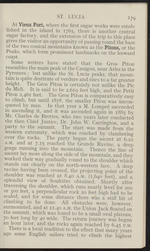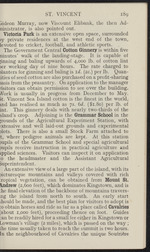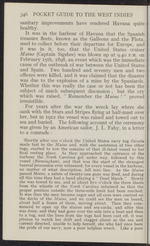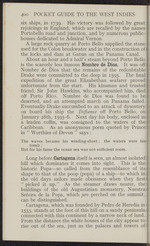| 1 |
 |
“...30 POCKET GUIDE TO THE WEST INDIES
of interest. With the sun glinting on their silvery wings,
they look like dragon-flies as they leap from the sea in
shoals near the bows of the ship. That they actually
fly cannot be denied, but their flight appears to be like
that of the original “ glider ” aeroplane, requiring some
considerable impetus to give it a start, which is soon
expended. The fish forces its way through the water,
and, rising from it, is carried forward and skims the
surface, gaining momentum each time it touches the
waves. The size of the fish is that of a small herring
and there are always many old travellers who will tell
one how they have seen them fly on board the ship,
though really this can only occur on sailing ships, whose
gunwales are near the water—as described by Jeaffreson
in 1676 (see next page)—unless, perhaps, the fish with
unerring aim flies through the port-hole.
The first sight of the island of Barbados is, as a rule,
obtained overnight, when the Ragged Point...”
|
|
| 2 |
 |
“...destitute of verdure and rises to a far greater
height. The Gros Piton is certainly not unlike the Pic
du Midi. It is said to be 2,619 feet high, and the Petit
Piton 2,461 feet. The Gros Piton is comparatively easy
to climb, but untU 1878, the smaller Piton was uncon-
quered by man. In that year a M. Lompré succeeded
in ascending it, and it was ascended again in 1885 by
Mr. Charles de Brettes, who two years later conducted
the then Chief Justice, Dr. John W. Carrington, and a
party to the summit. The start was made from the
western extremity, which was reached by clambering
over the rocks. The party began the ascent at 6.22
a.m. and at 7-J5 reached the Grande Ravine, a deep
gorge running into the mountain. Thence the fine of
ascent lay more along the side of the mountain, and they
worked their way gradually round to the shoulder which
stands out clearly on the north-western face. A deep
ravine having been crossed, the projecting point of the
shoulder was reached at 8.40 a.m. (1,640 feet), and a...”
|
|
| 3 |
 |
“...Dupils receive instruction in practical agriculture and
tpplied sciences. Visitors can inspect it on application
:o the headmaster and the Assistant Agricultural
superintendent.
An extensive view of a large part of the island, with its
picturesque mountains and valleys covered with rich
:ropical vegetation, can be obtained from Mount St.
Andrew (2,600 feet), which dominates Kingstown, and is
:he final elevation of the backbone of mountains travers-
ng the island from north to south. An early start
should be made, and the best plan for visitors to adopt is
to obtain horses and ride as far as a place called Cavalries
(about 1,000 feet), proceeding thence on foot. Guides
:an be readily hired for a small fee either in Kingstown or
Lowman’s village (2 miles), which is passed on the way ;
the time usually taken to reach the summit is two hours.
In the neighbourhood of Cavalries the unique Soufrière...”
|
|
| 4 |
 |
“...was raised and towed out to
sea and burred. The following account of the ceremony
was given by an American sailor, J. L. Fahy, in a letter
to a comrade:
Shortly after one o’clock the United States navy tug Osceola
made fast to the Maine and, with the assistance of two other]
tugs, started to tow the remains of that ill-fated vessel to her
final resting place. As they approached the entrance of the;
harbour the North Carolina got under way, followed by this
vessel (Birmingham), and that was the start of the strangest:
funeral procession ever witnessed, for every vessel in the harbour, j
no matter of what description, fell into line. As the Maine
passed Morro, a salute of twenty-one guns was fired, and during
all this time they had a band playing a “ Dead March.” Slowly ;
she was towed to sea, and at about five o’clock the three blasts j
from the whistle of the North Carolina informed us that the j
proper position outside the three-mile limit had been reached.
It was then the men became eager...”
|
|
| 5 |
 |
“...by numerous public-
houses dedicated to Admiral Vernon.
A large rock quarry at Porto Bello supplied the stone
used for the Colon breakwater and in the construction of
the locks and dam at Gatun on the Panama Canal.
About an hour and a half’s steam beyond Porto Bello
is the scarcely less famous Nombre dé Dios. It was off
Nombre de-Dios that the remains of the redoubtable
Drake were committed to the deep in 1595. The final
expedition of the great Elizabethan seafarer proved
unfortunate from the start. His kinsman and trusted
friend, Sir John Hawkins, who accompanied him, died
off Porto Rico. Nombre de Dios was found to be
deserted, and an attempted march on Panama failed.
Eventually Drake succumbed to an attack of dysentery
on board his ship the Defiance off Porto Bello, on|o]
January 28th, 1595-6. Next day his body, enclosed in [I
a leaden coffin, was consigned to the waters of the*
Caribbean. As an anonymous poem quoted by Prince
in “ Worthies of Devon ” says :
The waves became his wind...”
|
|
| 6 |
 |
“...ingenious conveyors worked by motors
supplied with steam from the ships’ boilers) there is
usually ample time to permit of visitors proceeding by
train to San José, the capital of Costa Rica (103 miles)
and back, a mountain excursion of rare charm and
interest which should on no account be missed. The
station of the Ferrocarril de Costa Rica is at the short
end of the pier, but special trains, which can be engaged
by wireless at twenty-four horns’ notice for parties of
fifty persons or more, start from alongside the steamer.
It is advisable to take food for the journey and also
warm wraps.
The line, which was built by an American, the late
Minor C. Keith, between 1884 and 1900, is now leased
to the Northern Railway Company and by them to the
United Fruit Company, who use it for transporting
bananas and coffee to the coast. In 1880 only 360:
bunches of bananas were exported; but after the opening!
of the railway the quantity increased rapidly until it
reached ten to twelve million bunches...”
|
|
| 7 |
 |
“...the baling-room, where
it is baled under pressure. It is then ready for shipment. In
the lowest room the seed is stored for planting the next season's
crop, for feeding the animals, or for making manure.
THE BALATA INDUSTRY. A balata industry exists in
British Guiana. Balata is a gutta-percha-like substance which
is tapped from a forest tree known as the Bullet tree or Mimusops
globosa. It is used for insulating purposes, and also in the
manufacture of belting and boots and shoes. Expeditions
start periodically to the interior to collect the substance. The
tapping of balata trees is done with the cutlass, incisions being
made not more than i£ inches wide, about 10 inches apart, in
a “ feather-stitch ” pattern up the trunks of the trees. The
latex runs in zigzags from cut to cut into a calabash at the base
of the tree. The latex is collected from the calabashes into
gourds (goobees) and then it is taken to the camp, where it is
poured into shallow trays (dabrees) that hold from five to thirty...”
|
|
| 8 |
 |
“...444 POCKET GUIDE TO THE WEST INDIES
The twelfth Earl of Dundonald was also an oil pioneer. In
1907 a new Trinidad Petroleum Company started to bore on
land owned by him and Dr. de Wolf near the Pitch Lake with
so great a measure of success that they were very soon able to
dispose of the venture to the Trinidad Oilfields, Ltd., a company
which was successfully floated in 1910. This was the signal
for the start of a boom in oil-bearing lands and licences in
Trinidad. Within a year, companies with a nominal capital of
upwards of £2,500,000 were formed.
Meanwhile development work steadily proceeded, and in
addition to the Canadian and the English companies above
referred to, the concessionaires of the Pitch Lake were boring
for oil under the name of the Trinidad Lake Petroleum Company,
Ltd., and meeting with very favourable results.
On April 20th a small party of guests visited Brighton, Trini- j
dad, at the invitation of the Trinidad Lake Petroleum Company, •
Ltd., and witnessed the inauguration...”
|
|
